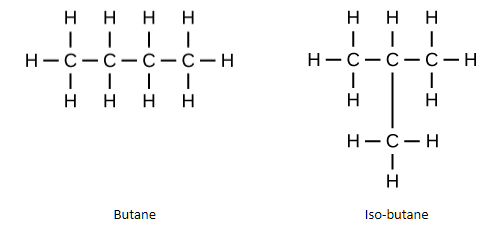
The atoms of different elements having the same number of neutrons is known as:
A.Isobars
B.Isomers
C.Isotones
D.Isotopes
Answer
568.5k+ views
Hint: When encountering such terms like ‘isobars’, we must understand what they mean. The word ‘iso’ stands for the same. To solve this question, we will first understand the definition of each term mentioned and then interpret the correct option.
Complete step by step answer:
Isotopes are defined as the group of the same elements that have different numbers of neutrons but the same number of protons and electrons.
Example – The isotopes of Hydrogen are – \[{^1_1}H\] - Protium, \[{^2_1}H\] - Deuterium and \[{^3_1}H\] - Tritium.
Isomers are molecules that have the same molecular formula but different structural formula.
Example – The isomers of butane are –

Isotones are a group of atoms of different elements that have the same number of neutrons but different number of protons.
Example – Oxygen \[{_8^{16}}O\] , Nitrogen \[{^{15}_7}N\] and Carbon \[{^{14}_6}C\] have same number of neutrons, i.e., 8. Hence, they are called isotones.
Isobars are different elements that have different atomic numbers but have the same mass number.
Example – An example of pair of isobars is \[^{40}S{,^{40}}Ca{,^{40}}K{,^{40}}Ar{,^{40}}Cl\] .
Hence, the correct answer is (C) i.e., isotones.
Note: In a given pair of isotones, the element with the higher atomic number, would have the higher atomic mass number out of the two. This tells us that the mass of the element with the higher atomic number would be higher. So, this gives us more information about isotones.
Complete step by step answer:
Isotopes are defined as the group of the same elements that have different numbers of neutrons but the same number of protons and electrons.
Example – The isotopes of Hydrogen are – \[{^1_1}H\] - Protium, \[{^2_1}H\] - Deuterium and \[{^3_1}H\] - Tritium.
Isomers are molecules that have the same molecular formula but different structural formula.
Example – The isomers of butane are –

Isotones are a group of atoms of different elements that have the same number of neutrons but different number of protons.
Example – Oxygen \[{_8^{16}}O\] , Nitrogen \[{^{15}_7}N\] and Carbon \[{^{14}_6}C\] have same number of neutrons, i.e., 8. Hence, they are called isotones.
Isobars are different elements that have different atomic numbers but have the same mass number.
Example – An example of pair of isobars is \[^{40}S{,^{40}}Ca{,^{40}}K{,^{40}}Ar{,^{40}}Cl\] .
Hence, the correct answer is (C) i.e., isotones.
Note: In a given pair of isotones, the element with the higher atomic number, would have the higher atomic mass number out of the two. This tells us that the mass of the element with the higher atomic number would be higher. So, this gives us more information about isotones.
Recently Updated Pages
Why are manures considered better than fertilizers class 11 biology CBSE

Find the coordinates of the midpoint of the line segment class 11 maths CBSE

Distinguish between static friction limiting friction class 11 physics CBSE

The Chairman of the constituent Assembly was A Jawaharlal class 11 social science CBSE

The first National Commission on Labour NCL submitted class 11 social science CBSE

Number of all subshell of n + l 7 is A 4 B 5 C 6 D class 11 chemistry CBSE

Trending doubts
What is meant by exothermic and endothermic reactions class 11 chemistry CBSE

10 examples of friction in our daily life

One Metric ton is equal to kg A 10000 B 1000 C 100 class 11 physics CBSE

1 Quintal is equal to a 110 kg b 10 kg c 100kg d 1000 class 11 physics CBSE

Difference Between Prokaryotic Cells and Eukaryotic Cells

What are Quantum numbers Explain the quantum number class 11 chemistry CBSE




